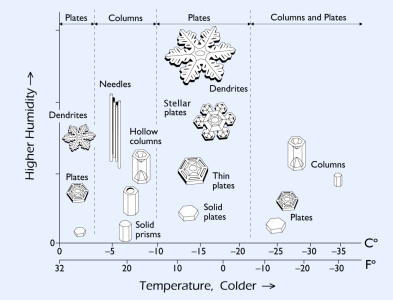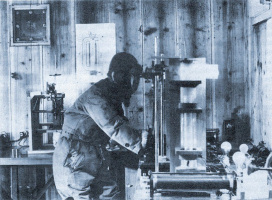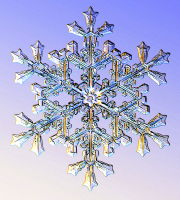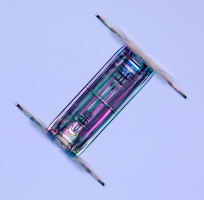|
|
 The Snow Crystal Morphology Diagram,
shown on the right, indicates what kinds of snow crystals grow at
specific temperatures and humidity levels. This is important
information for understanding snow crystal formation, yet it remains
something of a scientific mystery. The Snow Crystal Morphology Diagram,
shown on the right, indicates what kinds of snow crystals grow at
specific temperatures and humidity levels. This is important
information for understanding snow crystal formation, yet it remains
something of a scientific mystery.
You can see two main trends in this diagram:
1)
Snow crystal formation changes rather dramatically with temperature --
thin plate-like crystals appear at temperatures near -2 C (28 F),
slender columns grow near -6 C (21 F), large thin plates grow near -15
C (5 F), and one can find either plates or columns at lower
temperatures.
2) Snow crystals grow into simpler forms when the
humidity is low and the crystals grow slowly. More complex, branched
forms appear when the humidity is high and the crystals grow rapidly.
Click on the image for a larger version of the Morphology Diagram, or here for a still larger version.
|
|  Discovery Discovery
The
Snow Crystal Morphology Diagram was discovered in the 1930s by Japanese
physicist Ukichiro Nakaya and his collaborators, and it is sometimes
called the Nakaya Diagram for
this reason. They grew snow crystals in their cold lab at different
temperatures and humidity levels and observed the different forms. The
photo on the right shows Nakaya peering through his microscope at some
snow crystals growing in his refrigerated laboratory.
The
diagram has been extended and refined over the years by other
researchers, but its fundamental characteristics have remained
unchanged.
Nakaya used to say that snowflakes are like
hieroglyphs from the clouds, because you can infer the conditions in
the clouds by examining the shapes of the falling snow crystals. |
|  Snowflake Hunting Snowflake Hunting
If
you ever go looking for beautiful stellar snowflakes outside, remember
the snow crystal morphology diagram. For example, you are most likely
to find large, plate-like crystals when the temperature is *cold*, near
-15 C (5 F). Plate-like crystals also appear near -2 C (28 F), but
these are smaller and are prone to melting (because the temperature is
so close to the melting point).
When I am photographing snowflakes, I am more likely to find spectacular specimens (what I like to call the Greatest Snow on Earth) in places where the average temperature is around -15 C (5 F) and it snows frequently. |
|  Explaining Snowflakes Explaining Snowflakes
The
morphology diagram provides a handy explanation for the formation of
odd-looking snow crystal forms like capped columns. The crystal on the
right, for example, must have started growing at temperatures near -6 C
(21 F), forming a stout columnar crystal. Then the wind carried it to
colder temperatures, so thin plates grew on the ends of the columns.
|
| The Road to Understanding
Observing the growth of snow crystals in the lab is one thing, understanding it is something else entirely. The branching instability
does a pretty good job of explaining the origin of complex structures
in snow crystals, and it also explains how snow crystal morphologies
change with humidity. Higher humidity means faster growth, and the
branching instability is enhanced when growth is rapid. For the fastest
growing crystals (fernlike stellar dendrites), the branching becomes essentially chaotic in nature, with sidebranches appearing somewhat randomly along the main branches.
What science still cannot explain is why snow crystals grow as thin plates or slender columns depending on temperature. The sharpening instability
plays a role in this, but this instability is itself not well
understood. In the final analysis, the growth morphologies depend on
the detailed molecular structure and dynamics of the different ice
surfaces, and surface physics is complicated. Someday it will all be
understood, but for now there remains a bit of mystery in the formation
of a snowflake. |
|
|
|
